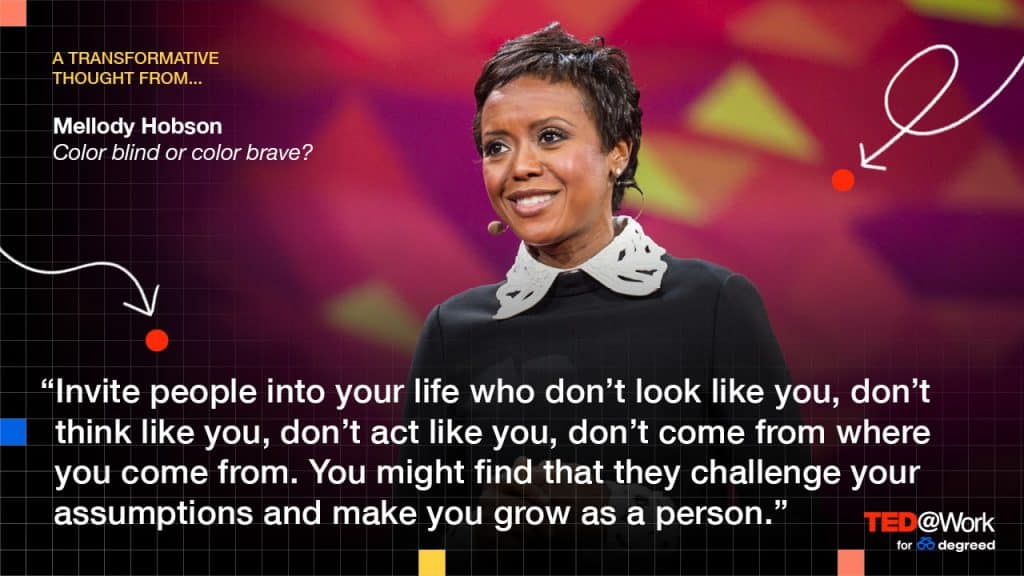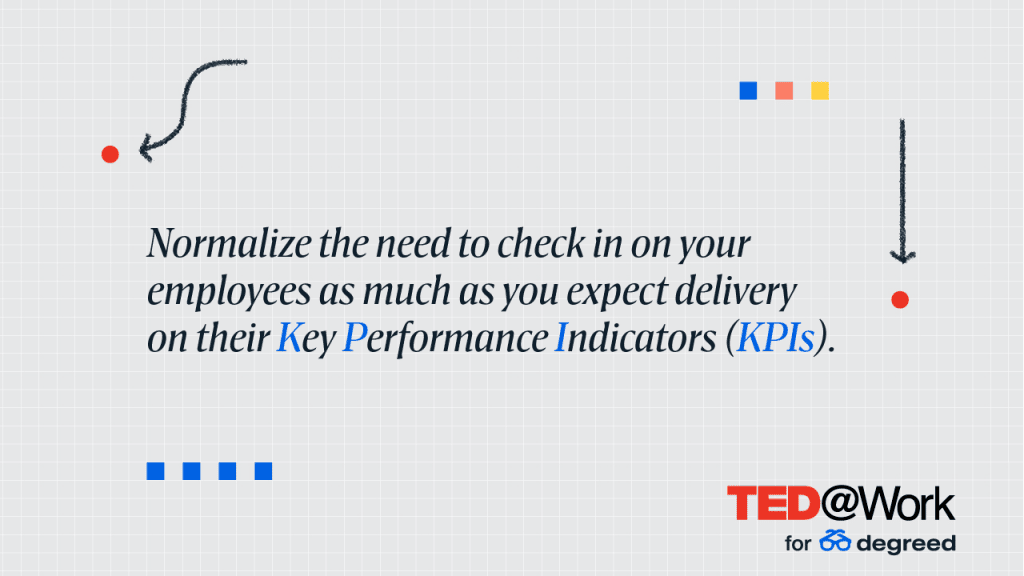Race, ethnicity, and diversity are touchy subjects for many. And they’re topics that many people and organizations often tip-toe around or avoid altogether. However, openly discussing race and other Diversity Equity Inclusion (DEI) issues is one key measure separating good organizations from great ones. A diverse and inclusive workplace often has higher revenue growth, the ability to recruit more candidates, higher retention rates, more innovation, and overall higher rates of satisfaction and pride in their employees.
That is why we’re proud of the TED@Work for Degreed integration that chooses to embrace and openly explore the topic of race. TED@Work aims to infuse corporate environments with a unique style of experiential learning. Our most recent example of this was a facilitated, safe, and honest internal workshop we held in March.
50 Degreed employees gathered virtually for this first-ever internal TED@Work for Degreed workshop. Degreed’s RaceEQ – a Business Resource Group (BRG) — led the conversation. RaceEQ understood that underrepresented minorities rarely felt they could voice their concerns, nor were they extended equitable practices — this fueled our intention behind hosting such an important event. The group collectively watched and explored Mellody Hobson’s “Color blind or color brave?” from the TED@Work for Degreed Preview. Listed as one of the most powerful women by Forbes in 2020, Hobson has a successful career as a businesswoman and is currently the President and co-CEO of Ariel Investments.

In her engaging TED Talk, Hobson makes the case that speaking openly about race — and particularly about diversity in hiring — makes for better businesses and a better society. Hobson’s TED Talk has more than 4.4 million views and has inspired the minds of many — so it’s no surprise that it was well-received by the Degreed employees in attendance.
Creating Safe Spaces
To support interactive workshops such as this, TED@Work had various resources and suggestions that made our experience of talking about a sensitive topic a little more seamless.
Hobson’s TED Talk acted as an anchor to our discussion, which was held virtually over Zoom. After we collectively watched the talk, we split into breakout rooms. Upon TED’s recommendation (outlined in the materials), we kept groups to a small number for easier conversation.
All participants received a My Idea Log, a note-taking sheet provided by TED. Additionally, all facilitators of the breakout groups received a 1-pager created by TED to help foster the group conversations. The resource helped facilitators establish and lead conversations without making anyone feel isolated. The result was an inclusive environment where each attendee could participate however they felt comfortable.
Three Takeaways From Our Workshop
Building an inclusive, diverse, and safe company culture is much like building other skills. It must be done intentionally and over time. Perhaps your people want to have their own open conversations. Here’s what we learned:
1. Start with vulnerability. In our workshop, some participants expressed concern that speaking out would do more harm than good. They said that they feared negative repercussions if they said something unintentionally offensive or incorrect. Because they were afraid of being viewed by peers as not ‘woke’, they preferred to avoid conversations about race.
Other participants welcomed conversations about race. They said that learning about topics, such as race, is most authentic when they embrace vulnerability. They appeared open to discussions in which they’re comfortable being uncomfortable; they wanted to listen, learn, reflect, and try to be better humans. TED’s note-taking resource, My Idea Log, allowed employees to write and formulate their thoughts to have meaningful discussions.
Being vulnerable and striving to cultivate a sense of allyship with colleagues and peers is crucial to a successful conversation about race. Being an ally means using your own power or privilege to uplift others, working to change your culture so that everyone is treated fairly, and listening and speaking up even when it’s uncomfortable. Encouraging vulnerability — even mistakes — is a pivotal part of making progress. In fact, there are other great TED Talks on allyship that we may use in later workshops.
2. Go from color blind to color brave. One group of participants said that everyone should be treated the same and be able to engage in a meaningful productive and constructive discussion. This approach is described in Hobson’s talk as color blind. This is when people claim to not see race. While this might seem great in theory, it can exclude the unique experiences of marginalized people. It’s a dangerous practice because it can ignore the problem.
In contrast, another group of participants resonated with Hobson’s description of being color brave. This is the belief that candid conversations about race help us to better understand each other’s perspectives and experiences, which leads to more informed decisions that cultivate an inclusive workforce. This group said that being color brave means acknowledging the differences we all have (including race, country of origin, sexual orientation, and gender) and viewing diversity as a competitive advantage.

Being color brave is the very core point of Hobson’s TED Talk, and it’s why the video remains relevant years after it was made. It sparks creative discourse in a professional context. And it leads us to think about the practices we’re currently implementing; are they color blind or color brave?
3. Include leadership. Many workshop participants agreed that managers and executives should set the tone and lead the charge for more conversations about race — and that they are uniquely positioned to create a safe space for discussions. To do this, people leaders can check in on workers during times of grief and hardship but also without a prompt. Managers can make or break a company culture, and it’s important to keep analyzing your organization’s approach as your workplace evolves.
How can leaders do more of this? Discuss color blindness to start a conversation, then ask color-brave questions. Starting conversations where people are most comfortable and gently moving toward a more progressive understanding can be beneficial. And normalize the need to check in on your employees as much as you expect delivery on their Key Performance Indicators (KPIs).
These are simple yet effective steps that any leader or person of influence can adopt and take action on immediately. Nothing can change a company culture overnight, but practicing a color brave approach is a great first step to welcoming diverse thoughts and open feedback.
Looking Forward
Our conversation about race at Degreed and our experience with TED@Work were meaningful in several ways. We regularly connect to ensure we provide a top-class experience for our customers, but we seldom discuss ways to be better colleagues to each other. We’ve all sat through webinars before, barely having meaningful conversations or leaving with much impact. It’s time to change our approach and to be color brave — by having uncomfortable conversations with each other.
This was our first attempt at a workshop experience like this, so we weren’t sure what to expect. But after the workshop ended, all participants were able to partake in a survey in which 90% responded that they were very satisfied with the workshop and were likely to participate in a similar event in the future. Our TED@Work workshop left us feeling vulnerable, inspired, and motivated to continue creating an equitable workplace at Degreed.
If your organization has similar goals, try an interactive workshop approach, and maybe you’ll find the same. There is more to discover through TED@Work for Degreed with 600+ TED Talks and TED-Ed animations supporting business-critical skills like team-building, managing stress, and inclusive leadership. All TED content is tagged against the Degreed skills taxonomy and built natively into Degreed.
